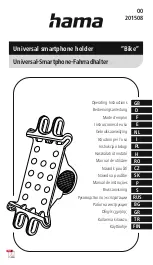
28
All information included in this manual is relevant to your own safety and that of your
environment. If you have any questions about the information included in this manual, consult a
professional or contact the Authorised Service Centre. The following information on hazards and
precautions includes the most probable situations that may arise during the use of this machine.
Check all the documentation, packaging and product labels before using it. If you encounter a
situation not described in this manual use common sense to use the machine as safely as possible
and, if you see any danger, do not use the machine.
ELECTRICAL SAFETY
• Battery tools do not need to be connected to an electrical outlet; therefore, they are always
in working order. Be aware of potential hazards when not using the battery tool or when
changing accessories. Following this rule will reduce the risk of electric shock, fire or serious
injury.
• Do not place battery tools or their batteries near a fire or heat source. Following this rule will
reduce the risk of serious injury.
• Do not crush, drop or damage the battery. Do not use a battery or charger that has been
dropped or hit hard. Immediately discard a dropped or damaged battery.
• Do not charge the battery tool in a wet or damp place. Following this rule will reduce the
risk of electric shock.
• For best results, the battery tool should be charged in a location where the temperature is
above 10°C but below 40°C. To reduce the risk of serious injury, do not store it outside or
in a vehicle.
• Under extreme temperature conditions or overuse, battery leaks may occur. If liquid comes
into contact with skin, wash immediately with soap and water, then neutralize with lemon
juice or vinegar. If liquid gets into the eyes, rinse them with clean water for at least 10
minutes, then seek medical attention immediately. Following this rule will reduce the risk
of serious injury.
• Keep these instructions. Check them frequently and use them to ask others to use this tool.
If you lend this tool to someone, also lend them these instructions to avoid misuse of the
product and possible injury.
USE AND MAINTENANCE OF BATTERY-POWERED TOOLS
• Charge only with the charger specified by the manufacturer. A charger suitable for one type
of battery can create a fire hazard when used with another battery.
• Use battery tools only with specially designed batteries. Use of other batteries may create
a risk of injury and fire.
• When the battery is not in use, keep it away from other metal objects such as pliers, coins,
keys, nails, screws or other small metal objects that can establish a connection from one
terminal to another. A short circuit in the battery terminals may cause burns or fire.
• Under abusive conditions, liquid may be expelled from the battery; avoid contact. In case
of accidental contact, rinse with water. If liquid comes into contact with eyes, consult a
physician. Liquid expelled from the battery may cause irritation or burns.
















































